Unit 3--1 教案纸
- 格式:doc
- 大小:92.50 KB
- 文档页数:10
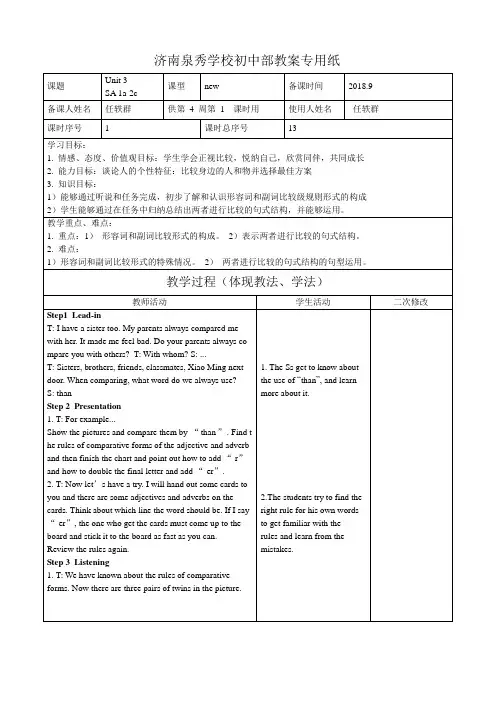

英语三下一单元英文教案Unit 3 Lesson Plan for English Class。
Title: Exploring the World of Animals。
Objective: By the end of the lesson, students will be able to identify and describe different types of animals, their habitats, and their characteristics.Materials: 。
Pictures of different animals。
Worksheet with questions about animals。
Whiteboard and markers。
Animal sound recordings。
Introduction (10 minutes)。
Greet the students and ask them to sit in a circle.Show the students pictures of different animals and ask them to identify each animal.Discuss with the students what animals they know and where they live.Activity 1: Animal Sounds (15 minutes)。
Play recordings of different animal sounds and ask the students to guess which animal is making the sound.Discuss with the students the different sounds that animals make and why they make those sounds.Activity 2: Animal Characteristics (20 minutes)。

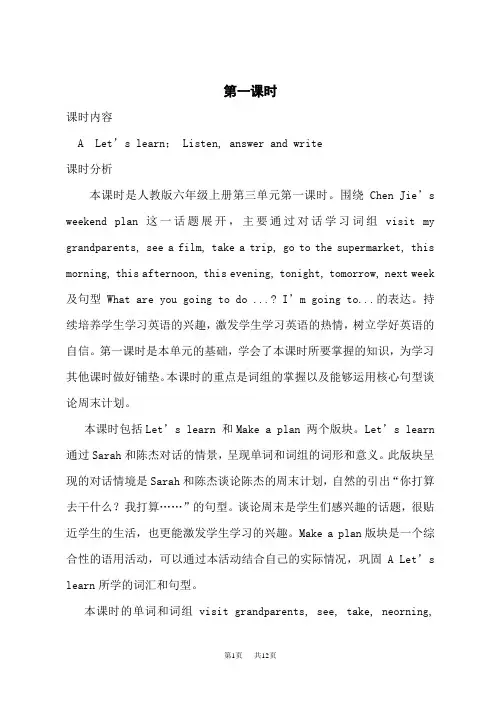
第一课时课时内容A Let’s learn; Listen, answer and write课时分析本课时是人教版六年级上册第三单元第一课时。
围绕Chen J ie’s weekend plan这一话题展开,主要通过对话学习词组visit my grandparents, see a film, take a trip, go to the supermarket, this morning, this afternoon, this evening, tonight, tomorrow, next week 及句型What are you going to do ...? I’m going to...的表达。
持续培养学生学习英语的兴趣,激发学生学习英语的热情,树立学好英语的自信。
第一课时是本单元的基础,学会了本课时所要掌握的知识,为学习其他课时做好铺垫。
本课时的重点是词组的掌握以及能够运用核心句型谈论周末计划。
本课时包括Let’s learn 和Make a plan 两个版块。
Let’s learn 通过Sarah和陈杰对话的情景,呈现单词和词组的词形和意义。
此版块呈现的对话情境是Sarah和陈杰谈论陈杰的周末计划,自然的引出“你打算去干什么?我打算……”的句型。
谈论周末是学生们感兴趣的话题,很贴近学生的生活,也更能激发学生学习的兴趣。
Make a plan版块是一个综合性的语用活动,可以通过本活动结合自己的实际情况,巩固 A Let’s learn所学的词汇和句型。
本课时的单词和词组visit grandparents, see, take, neorning,afternoon, evening, tomorrow,虽然没有集中涉及过,但是学生曾经学生,有一定的基础。
在设计教学过程时,先用游戏、简笔画猜一猜的活动激活旧知,然后结合教材设置的情境学习新知,运用听、说、读、写、玩等多种教学手段帮助学生理解和巩固所学新知,全面调动学生的积极参与,让学生在快乐的氛围中学会知识。
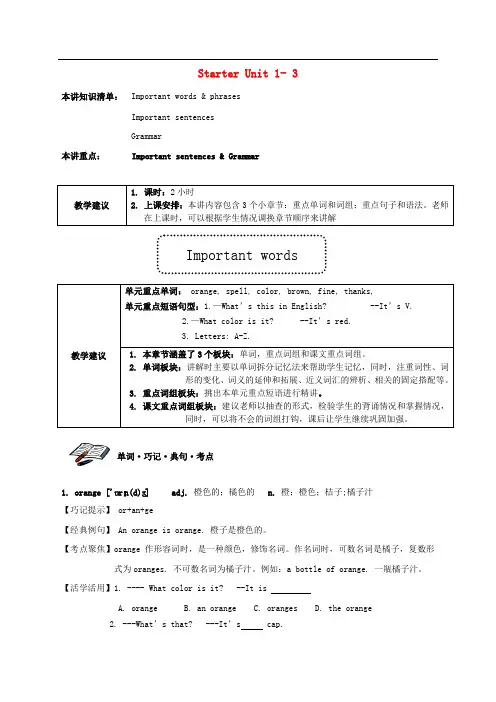
Starter Unit 1- 3 本讲知识清单:Important words & phrasesImportant sentencesGrammar本讲重点: Important sentences & Grammar教学建议1. 课时:2小时2. 上课安排:本讲内容包含3个小章节:重点单词和词组;重点句子和语法。
老师在上课时,可以根据学生情况调换章节顺序来讲解教学建议单元重点单词: orange, spell, color, brown, fine, thanks,单元重点短语句型:1.—What’s this in English? --It’s V.2.—What color is it? --It’s red.3. Letters: A-Z.1. 本章节涵盖了3个板块:单词,重点词组和课文重点词组。
2. 单词板块:讲解时主要以单词拆分记忆法来帮助学生记忆,同时,注重词性、词形的变化、词义的延伸和拓展、近义词汇的辨析、相关的固定搭配等。
3. 重点词组板块:挑出本单元重点短语进行精讲。
4. 课文重点词组板块:建议老师以抽查的形式,检验学生的背诵情况和掌握情况,同时,可以将不会的词组打钩,课后让学生继续巩固加强。
单词·巧记·典句·考点1. orange['ɒrɪn(d)ʒ] adj. 橙色的;橘色的 n. 橙;橙色;桔子;橘子汁【巧记提示】 or+an+ge【经典例句】 An orange is orange. 橙子是橙色的。
【考点聚焦】orange 作形容词时,是一种颜色,修饰名词。
作名词时,可数名词是橘子,复数形式为oranges. 不可数名词为橘子汁。
例如:a bottle of orange. 一瓶橘子汁。
【活学活用】1. ---- What color is it? --It isA. orangeB. an orangeC. orangesD. the orange2. ---What’s that? ---It’s cap.Important wordsA. orangeB. an orangeC. a orangeD. the orangeKey: 1. A; 2. B2. spell [spel] vt. 拼,拼写;【经典例句】 spell it ,please. 请拼写它。

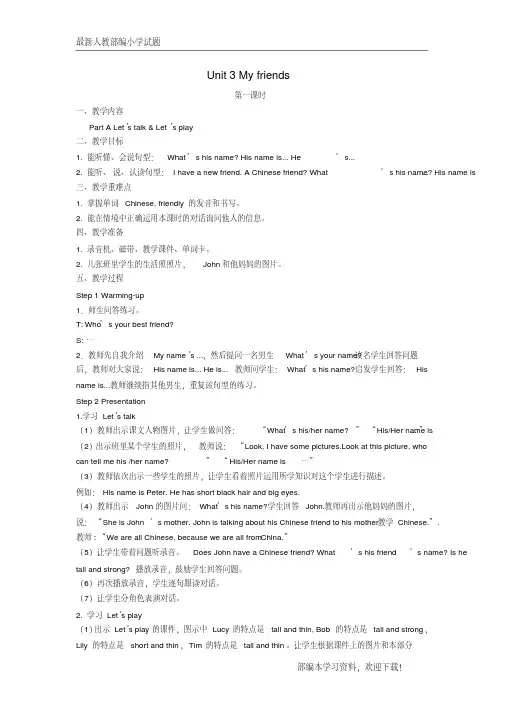
Unit 3 My friends第一课时一、教学内容Part A Let’s talk & Let’s play二、教学目标1. 能听懂、会说句型:What’s his name? His name is... He’s......2. 能听、说、认读句型:I have a new friend. A Chinese friend? What’s his name? His name is三、教学重难点1. 掌握单词Chinese, friendly的发音和书写。
2. 能在情境中正确运用本课时的对话询问他人的信息。
四、教学准备1. 录音机、磁带、教学课件、单词卡。
2. 几张班里学生的生活照照片,John和他妈妈的图片。
五、教学过程Step 1 Warming-up1.师生问答练习。
T: Who’s your best friend?S: …2.教师先自我介绍My name’s ...,然后提问一名男生What’s your name?该名学生回答问题后,教师对大家说:His name is... He is... 教师问学生:What’s his name? 启发学生回答:Hisname is...教师继续指其他男生,重复该句型的练习。
Step 2 Presentation1.学习Let’s talk... ”(1)教师出示课文人物图片,让学生做问答:“What’s his/her name?”“His/Her name is(2)出示班里某个学生的照片,教师说:“Look, I have some pictures.Look at this picture, whocan tell me his /her name? ”“His/Her name is…” (3)教师依次出示一些学生的照片,让学生看着照片运用所学知识对这个学生进行描述。
例如:His name is Peter. He has short black hair and big eyes.(4)教师出示John的图片问:What’s his name? 学生回答John.教师再出示他妈妈的图片,说:“She is John’s mother. John is talking about his Chinese friend to his mother”.教学Chinese.教师: “We are all Chinese, because we are all from China.”(5)让学生带着问题听录音。
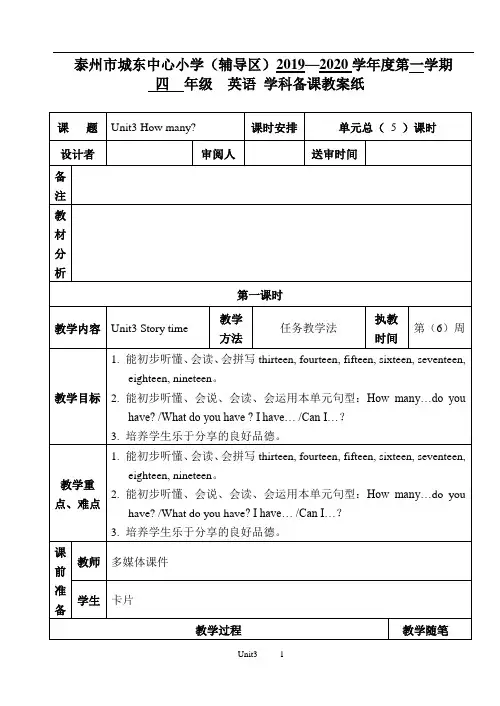
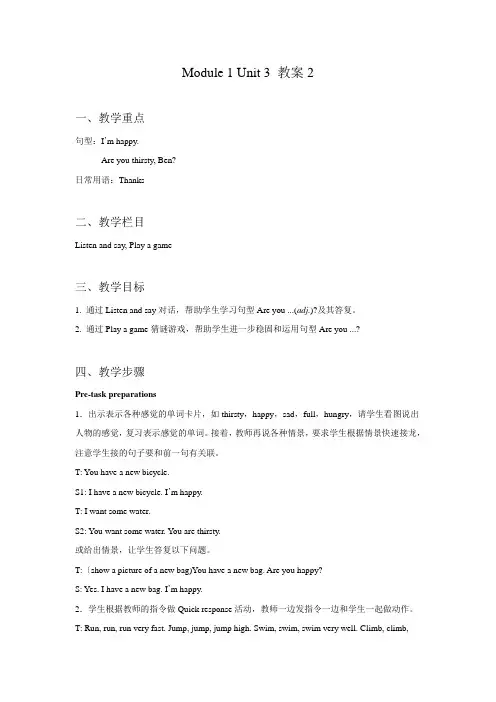
Module 1 Unit 3 教案2一、教学重点句型:I’m happy.Are you thirsty, Ben?日常用语:Thanks二、教学栏目Listen and say, Play a game三、教学目标1. 通过Listen and say对话,帮助学生学习句型Are you ...(adj.)?及其答复。
2. 通过Play a game猜谜游戏,帮助学生进一步稳固和运用句型Are you ...?四、教学步骤Pre-task preparations1.出示表示各种感觉的单词卡片,如thirsty,happy,sad,full,hungry,请学生看图说出人物的感觉,复习表示感觉的单词。
接着,教师再说各种情景,要求学生根据情景快速接龙,注意学生接的句子要和前一句有关联。
T: You have a new bicycle.S1: I have a new bicycle. I’m happy.T: I want some water.S2: You want some water. You are thirsty.或给出情景,让学生答复以下问题。
T:〔show a picture of a new bag)You have a new bag. Are you happy?S: Yes. I have a new bag. I’m happy.2.学生根据教师的指令做Quick response活动,教师一边发指令一边和学生一起做动作。
T: Run, run, run very fast. Jump, jump, jump high. Swim, swim, swim very well. Climb, climb,climb trees.Ss: (do the actions)学生跟着教师做好动作后,教师说I’m tired. Are you tired?,然后把句型写在黑板上。
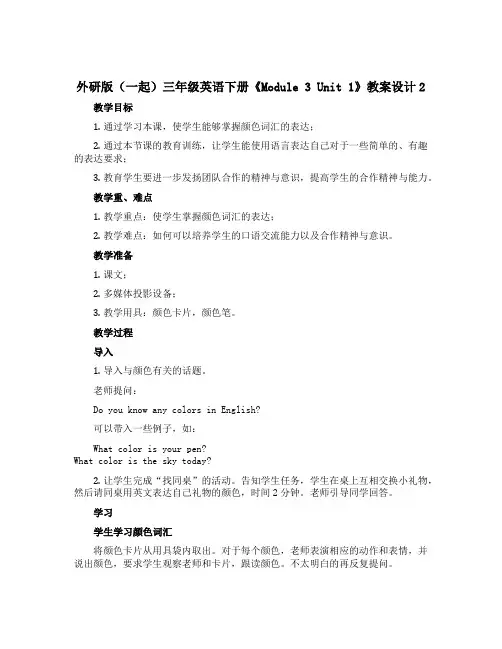
外研版(一起)三年级英语下册《Module 3 Unit 1》教案设计2教学目标1.通过学习本课,使学生能够掌握颜色词汇的表达;2.通过本节课的教育训练,让学生能使用语言表达自己对于一些简单的、有趣的表达要求;3.教育学生要进一步发扬团队合作的精神与意识,提高学生的合作精神与能力。
教学重、难点1.教学重点:使学生掌握颜色词汇的表达;2.教学难点:如何可以培养学生的口语交流能力以及合作精神与意识。
教学准备1.课文;2.多媒体投影设备;3.教学用具:颜色卡片,颜色笔。
教学过程导入1.导入与颜色有关的话题。
老师提问:Do you know any colors in English?可以带入一些例子,如:What color is your pen?What color is the sky today?2.让学生完成“找同桌”的活动。
告知学生任务,学生在桌上互相交换小礼物,然后请同桌用英文表达自己礼物的颜色,时间2分钟。
老师引导同学回答。
学习学生学习颜色词汇将颜色卡片从用具袋内取出。
对于每个颜色,老师表演相应的动作和表情,并说出颜色,要求学生观察老师和卡片,跟读颜色。
不太明白的再反复提问。
合作练习1.学生找一组,在教室内找出6个纯色的物品;2.在纸上画出一个6x6的方格,将颜色填充到其中,每个颜色占用不多于2个格子;3.看看有多少个颜色,如果不够10种,可以再添加,最终讨论,并找出英文,尝试翻译成自己的语句;4.每一组找出一个代表”小组颜色表“的同学,另一边的同学是要询问别的小组的颜色种类和具体颜色所在的位置的提问者,请完成这个活动。
5.结束后老师会随机点名学生,让他们向全班汇报。
评价1.在教室墙壁上贴上一个颜色方块,让学生把不同颜色的小纸条粘贴到相应的颜色中。
学生在班级内点击他们的颜色来表示他们在颜色界中的位置。
让同学说出自己的颜色,老师讲解每个学生颜色的英语表述;总结本节课教学重点在于使学生理解曼彻斯特街流行的简化版,帮助学生领会较新的口语交流的技术。
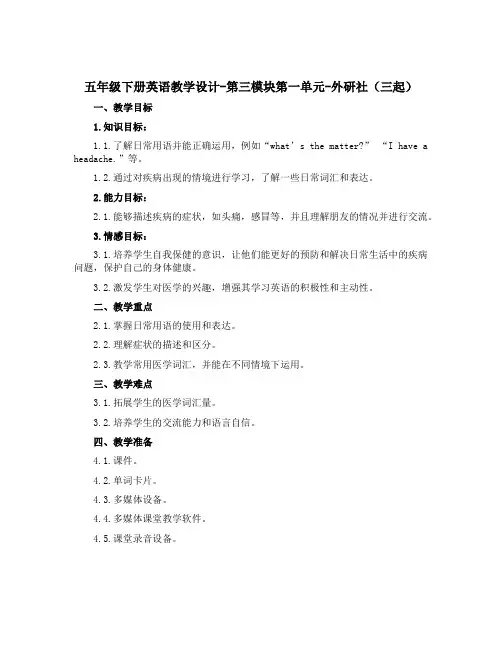
五年级下册英语教学设计-第三模块第一单元-外研社(三起)一、教学目标1.知识目标:1.1.了解日常用语并能正确运用,例如“what’s the matter?” “I have a headache.”等。
1.2.通过对疾病出现的情境进行学习,了解一些日常词汇和表达。
2.能力目标:2.1.能够描述疾病的症状,如头痛,感冒等,并且理解朋友的情况并进行交流。
3.情感目标:3.1.培养学生自我保健的意识,让他们能更好的预防和解决日常生活中的疾病问题,保护自己的身体健康。
3.2.激发学生对医学的兴趣,增强其学习英语的积极性和主动性。
二、教学重点2.1.掌握日常用语的使用和表达。
2.2.理解症状的描述和区分。
2.3.教学常用医学词汇,并能在不同情境下运用。
三、教学难点3.1.拓展学生的医学词汇量。
3.2.培养学生的交流能力和语言自信。
四、教学准备4.1.课件。
4.2.单词卡片。
4.3.多媒体设备。
4.4.多媒体课堂教学软件。
4.5.课堂录音设备。
五、教学过程5.1.引入:向学生介绍生活中常见的疾病,并提出大家对于疾病的看法及处理方式,以便从学生熟知的情境做引入。
例如:“有同学上课的时候会觉得头疼、生病等,有没有同学能给他们提点建议呢?”5.2.导入新课:5.2.1.温故知新:复习和做简单自我测试,口语表达练习,看图作文等,增进对一些单词的记忆和理解,强化学生记忆,实践运用所学知识的能力。
5.2.2.新课讲解:授课,涉及生词、短语和长句的学习;语音、语调、语音速度等语音技巧的讲解,表情包使用等。
5.3.课堂练习:5.3.1.口才练习:编写几个情境,组织学生模拟实际生活中的疑问和回答,要求同学小组之间互相配合,尽量达成最佳实践效果。
例如:“A:What’s the matter?”“B:I have a headache.”“A:Do you need to see a doctor?”“B:No, thank you. I only need to take some rest.”5.3.2.审查演讲:检查学生口语发音、语音、思维、技巧及表达力,鼓励大家多说,多用英语思考并开口讲出词汇和对话,效果会比较好。
高中英语必修三unit1教案教学目标1. 让学生掌握本单元的核心词汇和表达方式。
2. 培养学生通过语境理解词义和句意的能力。
3. 提高学生的听说读写综合运用能力,尤其是口语交际能力。
4. 引导学生了解和认识中西方文化差异,培养跨文化交际意识。
教学重点与难点- 重点:核心词汇的正确使用,以及日常交流中的常见表达。
- 难点:理解和运用抽象词汇进行实际交流。
教学准备- 教材内容熟悉:确保对课本内容有深入的理解。
- 多媒体课件:准备相关的图片、音频和视频材料以辅助教学。
- 互动活动设计:制定小组讨论、角色扮演等互动环节的计划。
教学过程导入阶段(Warming u)- 通过展示与主题相关的图片或视频,激发学生的兴趣。
- 提问学生关于主题的前置知识,为新课内容做铺垫。
呈现阶段(resentation)- 利用T呈现新单词和短语,结合例句讲解其用法。
- 教师领读单词和短语,注意发音和语调。
- 播放课文录音,让学生跟读,注意模仿语音语调。
练习阶段(ractice)- 分组练习对话,鼓励学生运用新学的表达进行交流。
- 完成课本上的练习题,巩固新知识点。
- 通过角色扮演等活动,让学生在情境中使用英语。
应用阶段(Alication)- 小组讨论相关话题,如文化交流的重要性等。
- 模拟真实场景,如在机场、酒店等情境下的交际对话。
总结与反馈(Summary and feedack)- 总结本节课学习的核心内容。
- 提供反馈,指出学生在学习过程中的优点和需要改进的地方。
作业布置- 背诵本单元的核心词汇和短语。
- 完成一篇关于文化差异的小短文,运用所学知识。
教学反思- 分析本节课的教学效果,记录学生的学习情况。
- 思考如何改进教学方法,提高学生的学习效率。
外研三起五年级下册英语Module 3 Unit 1 教案教学目标1.会听、说、读、写10个能力动词2.能够熟练运用能力动词进行描述3.了解动词的各种形式教学准备1.教科书和练习册2.一个大屏幕/白板和一台投影仪3.能力动词的图片或图标4.一份练习题和答案教学过程激发学生兴趣1.投影一些能力动词的图片或图标(例如:run,jump,climb,swim)并询问学生他们知道这些图片或图标代表着什么。
2.学生自由表达这些动词所代表的意思。
学习新知识1.联系上述激发兴趣的内容,老师向学生介绍单词并阐述每个能力动词的具体含义和英语读音。
2.学生跟读老师读出的单词。
学习技巧1.分成几组,每组一人上台向大家展示一个能力动词,并用英语进行表述。
2.老师提供语言和发音的纠正和指导。
3.每个小组展示完之后,全班鼓掌表示支持和鼓励。
巩固记忆1.给学生发放一份小练习,让学生用所学的能力动词填空。
这份练习既可以收集上课所学,又可以检验学生对新知识的掌握程度。
2.批改练习并公布答案。
3.老师询问学生哪些问题给他们带来了困惑,并用大屏幕或华盛顿范文的一些教育软件展示相应的解释和补充材料。
评估老师根据学生的学习效果和学生的表现评估学生的掌握程度。
可以通过口头测试或书面测试完成。
教学反思在本节课中,我们通过图片和单词的展示及学生讨论与分组展示来激发学生的学习兴趣。
我们还发放了一份练习来巩固学生对所学内容的理解程度。
结合讲义和视频教学,学生可以更方便,更清晰地理解所学内容,因此不会出现太大的困难。
新人教版三上英语(精通)教学设计Unit 1 GreetingsLesson 1教学目标:1.学生能够用正确的英语问候语进行自我介绍和问候他人。
2.学生能够识别并说出自己的名字和他人的名字。
3.学生能够理解并运用基本的日常问候用语。
教学重难点:•重点:掌握基本问候语(Hello, Hi, What's your name? 等)和自我介绍的表达方式。
•难点:在实际情境中灵活运用这些问候语,特别是面对不同的人群和场合。
教学环节:Step 1: Warm-up and Revision快速问答,用中文询问学生的名字,引导学生用英语回答(如“你叫什么名字?”- “我叫XXX”)。
Step 2: Lead-in1.展示一张包含不同人物的图片,引导学生用中文描述他们正在做什么(如“打招呼”)。
2.引入英语问候语的重要性,激发学生的兴趣。
Step 3: Presentation and Practice1.播放录音或教师示范对话,学生边听边理解对话内容。
2.教授新词汇和句型(Hello, Hi, What's your name? I'm ... 等),并通过实物、图片或手势帮助学生记忆。
3.分组练习,学生两两配对,模拟对话场景进行练习。
Step 4: Consolidation1.设计一个“Meet and Greet”活动,让学生在教室内自由走动,用所学问候语与不同同学打招呼并询问对方名字。
2.教师巡视指导,及时纠正发音和语法错误。
Step 5: Extension讨论不同场合下的问候方式,如第一次见面、老朋友重逢、告别等。
Step 6: Homework完成课后练习,包括书写自己的名字和简单的问候语对话。
教学目标:1.学生能够理解和运用“Good morning/afternoon/evening”等日常问候语。
2.学生能够通过听力和模仿练习,准确发出这些问候语的发音。
3.培养学生的礼貌用语习惯。
Unit 3 What would you like?教学目标1. 掌握A、B部分“Let’s learn”,“Let’s talk”中的词汇和句子。
2. 能就“食物”问题进行提问和回答,如“What would you like to eat?”,“I’d like …”3. 能与他人谈论自己最喜欢的食物。
4. 能用一些常用的形容词简单描述食物。
5. 学习双元音/əʊ/。
6. 能读懂“Story time”部分的趣味故事。
7. 能听懂、会唱歌曲“What would you like to eat today?”。
8. 在学习中了解一些西方国家的就餐礼仪,帮助学生形成良好的就餐习惯。
9. 激发学生的学习兴趣,鼓励学生在日常生活中多用英语进行交流。
教学重点1. 掌握A、B部分“Let’s learn”,“Let’s talk”中的词汇和句子。
2. 能就“食物”问题进行提问和回答,如“What would you like to eat?”,“I’d like …”3. 能与他人谈论自己最喜欢的食物。
教学难点1. 双元音/əʊ/的读法。
2. 单词“delicious”的发音。
3. 单词“hot”除了可以表示“热的”,还可以表示“辣的,辛辣的”。
第一课时:A. Let’s learn A. Role-play第二课时:A. Let’s try A. Let’s talk第三课时:B. Let’s learn B. Look, write and say第四课时:B. Let’s try B. Let’s talk第五课时:A. Let’s spell B. Let’s wrap it up第六课时:B. Read and write B. Let’s check C. Story time第一课时课时目标1. 能听、说、读、写单词“sandwich”,“salad”,“hamburger”,“ice cream”和“tea”。
江西外语外贸职业学院教案备课纸(2)江西外语外贸职业学院教案备课纸(3)主任审阅授课教师年月日年月日江西外语外贸职业学院教案备课纸(4)授课内容Unit 3 Road signs and commutingSection ⅠTalking Face to Face1.Warm-up Questions(1)Have you ever seen any bilingual road signs (in English and Chinese)? Do youthink they are helpful for foreigners to find directions when traveling in China? (2)Can you list some English words or phrases showing directions and locations? 2.Analyze the structure of the unit. Let the students know how to preview and myteaching process.3.Explain the structure of the map. And let the students talk face to face with theinformation from the map.4.Explain how to express the directions when you traveling the strange country andlet the students practice the conversation follow the samples.5.Explain the short dialogues, and then let the students practices the conversationswith their partner.6.Play the audio and let the students finish the exercises.江西外语外贸职业学院教案备课纸(3)主任审阅授课教师年月日年月日江西外语外贸职业学院教案备课纸(4)授课内容Unit 3 Road signs and commutingSectionⅡBeing All Ears1.Let the students train more how to express signs and directions to each other inorder to prepare for listening.2.Train listening: Listen to the audio, 1)Dialogue 2)Passage(1)Remind the students of some new words in the listening materials to write onthe blackboard.(2)Let the students listen to the materials of the dialogue and the passage.(3)Ask the students the answers, and then explain the listening materials andcorrect the wrong ones.江西外语外贸职业学院教案备课纸(3)主任审阅授课教师年月日年月日江西外语外贸职业学院教案备课纸(4)授课内容Unit 3 Road signs and commutingSection ⅢTrying Your HandsApplied Writing:Sample AnalysisThe teacher summarizes briefly the format and language used in signs. The teacher may show the following passage with PPT. Afterwards, ask the students to read it and translate it into Chinese orally.Signs are often used in public places to show the requirements for people, to give information or to attract people’s attention. Signs can be used for different purposes, for examples, traffic signs give you important information about traffic rules, warn you about dangerous road conditions and help you find your way.The language on signs features the use of short words and phrases, supported by different symbols in various colors and shapes for easy identification. Some signs are written or printed in capital letters.Some traffic signs:(1)Dead End Road (2) No Entry (3) Enter Here (4) No Way Out(5)Keep In LaneSome warning signs:(1)Dangerous (2) Pavement Narrows Ahead (3) Bicycle Crossing Ahead(4) Traffic Lights Ahead. Slow downSome Other signs:(1)Put Litter Here (2) Beware of Dog (3) No Business Today (4) For Rent1.Do the exercise in class.2.Check their answers.Sentence writing and grammar revision1.表示不可数名词的数量概念,要使用单位名词。
Unit 3 Sports and FitnessPeriod 5 Reading for Writing教材分析本单元我们从体育人物、体育竞技的角度讨论体育,而本课时为读写内容,要求学生从健康的角度探讨体育和人们日常生活的关系。
活动主题是“为健康手册编写一页内容”(Write a page in a wellness book)。
文章中描述了主人公健身前后的变化,并且收录在国外高中班级的健康手册中。
在阅读中要求学生理解文章,了解青少年应该具有的正确的健身态度和方式,学习比较和对比的写作方法。
同时,要求学生对自己的心理和身体健康进行反思,对比过去与现在或者将来的打算,培养关注健康的意识并形成正确的健康观。
教学目标1. To read and talk about the story of Kayla.2. To read for writing.3. To summarize the information and organization.4. To write a page for a class wellness book.教学重难点【教学重点】引导学生正确描述健康方面的问题和解决办法。
【教学难点】引导学生学会使用比较和对比的方法,描述事物前后的变化。
教学过程Step 1 Warming-up1. Free talking about health and fitness.(1) How do you keep fit?(2) List different ways of getting fit.设计意图:引导学生谈论自己的健身方法,并且提供图片以供同学讨论不同健身的方法,为引出本课时话题做好铺垫。
Step 2 Pre-readingWork in pairs. Guess what the passage is mainly about according to the theme of this unit and the title Going Positive.设计意图:通过小组活动,根据单元主题来预测文本内容的主旨大意。
Unit 3 Listening & SpeakingTeaching Procedure:I.Greetings and leading in.1.Today we’ll take up a new unit, Unit 3. In this unit, you’lllearn to ask questions to know customers’ need, understand the important role of a server and use up-selling techniques.II.Warm-up1.Activity 1: Some people are talking about the service they’vereceived. Have they received good or bad service? Write G for good or B for bad in the blanks.1)Discussion.2)Judge if the service is good or bad.3)Exchange their ideas.2.Activity 2: Discuss in groups: What should be done improvethe bad service mentioned above.3.Some points:1) The waiter was talking on the phone while taking my order.服务员一边给我点单一边打电话。
# on the phonee.g. You are wanted on the phone.# take one’s order 为……提供点菜服务。
e.g. May I take the order for you now? 现在可以为您点菜了吗?2) I asked a clerk for help and got an eye roll and big sigh as response.我请一名店员帮忙,得到的答复却是白眼,外加一声长叹。
# ask sb. for sth. 向某人要某物e.g. I asked him for help when I was in trouble.We can’t always ask our parents for money.# eye roll 眼球转动get an eye roll 被翻白眼# sigh [sai] n.叹息(声) vi.叹息,叹气big sigh 长叹3) The store clerk told me about a coupon that helped me save a lot.销售员告诉我可以使用优惠券,帮我省了不少钱。
# coupon n.礼券,优惠券# save a lot 节省很多…e.g. Here is a coupon for today’s bread.This coupon may save a lot for me.III.L istening and SpeakingA.Checking In1.New words and expressions.1) attend v. 照顾2) check in 登记住店R: check out3) clerk n. 旅馆服务台接待员;职员4) reservation n. 预订reserve v.5) correct adj. 正确的6) upper adj. 较高的7) away from 远离8) fill v. 填写fill in / out9) registration n. 登记10) form n. 表格fill out the registration form11) further adj. 更多的; 更远的;进一步的e.g. I will go abroad for further study.12) front desk 前台,总台13) assistance n. 帮助14) manage v. 能解决(问题);应付(困难局面等)2.Activity 1: Listen to the conversation and tick where ithappens.1). First show Ss three pictures and judge where theyshow.2). Listen to the CD and tick where it happens.3). Check up.3.Activity 2: Listen again. Then underline the questions askedby the hotel clerk..1). Ss listen to the tape and underline the questions.2). Check up.Clerk: Welcome to the Sheraton. May I help you?Guest: I’d like to check in. I have a reservation.Clerk: What’s your name, please?Guest: Phillip Parker.Clerk: Yes, Mr. Parker. You required a single room for three nights, is that correct?Guest: Yes, could I have a room on the upper floors, away from the street?Clerk: No problem. Could you fill out the registration form, please?Thank you. And will you be paying by cash or credit card?Guest: Cash, if you accept American dollars.Clerk: Of course, sir. Your room number is 1109. Here is your key.Enjoy your stay at the Sheraton. If you require anythingfurther, feel free to call the front desk. Would you likeassistance with your bags?Guest: No thanks, I only have one. I can manage.3). Read the dialogue.4). Act out the dialogue.5). Useful expressions.6). Some language points.1) I’d like to check in. I have a reservation.我要登记入住。
我预订过。
# check in 意为“登记入住”,check out 意为“结账离店”。
# have a reservation 意为“有预订”。
e.g. He has just checked in at the hotel.I’ll be checking out on Friday.2) You requested a single room for three nights, is that correct?您需要一间单人间住三晚,对吗?# a single room 意为“单人间”,a double room 意为“双人间”。
3) Could I have a room on the upper floors?我可以要一间位于较高楼层的房间吗?# on the upper floors 意为“在上面一点的楼层”,on the lower floor 在下面一点的楼层4) Could you fill out the registration form, please?# 您可以填一下这张登记表吗?# could you…? 意为“你能…吗?”委婉的语气,用在接待顾客中,比较正式而又礼貌# fill out the registration form 填写登记表fill out / in 意为“填写(表格)”。
e.g. Please fill out / in the application form.be filled with / be full of 充满e.g. The bottle was filled with / full of milk.The news filled her with hope.5) pay by cash or credit card# cash 意为“现金”,credit card信用卡,按发卡组织分:Visa 维萨卡MasterCard万事达卡、American Express美国运通卡、UnionPay银联卡等6) Enjoy your stay at the Sheraton. 祝您在谢尔顿酒店住的愉快!# stay 意为“停留、逗留”,住在酒店,不用live, 而用stay.e.g. How many nights will you be staying?7) feel free to 意为“请随意……”8) I can manage. 我能处理好。
# manage 意为“办理;设法对付”e.g. Can you manage it?Mr. White manages a large department store.manage to do sth. Compare: try to do sth.e.g. I managed to get there on time.He managed to finish the task at last.4.Activity 3: Suppose you work at the front desk of a hotel.Ask proper questions to get the following information.①name of the guestQuestion: What’s your name, please? / May I have your name,please?②kind of room neededQuestion: Do you prefer a smoking or non-smoking room? / Whatkind of room would you like, a single or a double? /Would you prefer a single or double?③number of guestsQuestion: How many of you?④length of stayQuestion: How long will you be staying?5.Activity 4: Complete the conversation and then role-play itwith your partner.Front Desk: Welcome to the Home Inn. How may I help you?Guest: I’d like a room, please.Front Desk: Single or double?Guest: A double, please. How much is that?Front Desk: It’s $ 145.00 a night. How long will you stay?Guest: Just tonight.Front Desk: OK. One night comes to $ 145.00 plus tax. May I haveyour name?Guest: It’s Davies. Robert Davies.Front Desk: How to spell?Guest: It’s D-A-V-I-E-S.# come to 意为“总计为”。